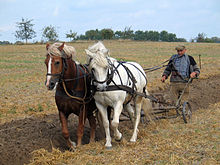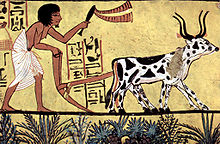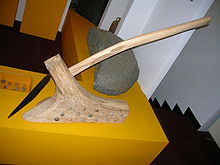
Plough
About this schools Wikipedia selection
SOS Children has tried to make Wikipedia content more accessible by this schools selection. All children available for child sponsorship from SOS Children are looked after in a family home by the charity. Read more...

The plough ( BrE) or plow (AmE; see spelling differences; pron.: / ˈ p l aʊ /) is a tool (or machine) used in farming for initial cultivation of soil in preparation for sowing seed or planting. It has been a basic instrument for most of recorded history, and represents one of the major advances in agriculture.
The primary purpose of ploughing is to turn over the upper layer of the soil, bringing fresh nutrients to the surface, while burying weeds, the remains of previous crops, and both crop and weed seeds, allowing them to break down. It also aerates the soil, allows it to hold moisture better and provides a seed-free medium for planting an alternate crop. In modern use, a ploughed field is typically left to dry out, and is then harrowed before planting. Ploughs were initially human powered, but the process became considerably more efficient once animals were pressed into service. The first animal powered ploughs were undoubtedly pulled by oxen, and later in many areas by horses (generally draught horses) and mules, although various other animals have been used for this purpose. In industrialised countries, the first mechanical means of pulling a plough were steam-powered ( ploughing engines or steam tractors), but these were gradually superseded by internal-combustion-powered tractors. In the past two decades plough use has decreased in some areas, often those significantly threatened by soil damage and erosion, in favour of shallower ploughing and other less invasive tillage techniques. Modern competitions take place for ploughing enthusiasts like the National Ploughing Championships in the UK.
Etymology
In English, as in other Germanic languages, the plough was traditionally known by other names, e.g. Old English sulh, Old High German medela, geiza, huohili, and Old Norse arðr ( Swedish årder), all presumably referring to the scratch plough ( ard).
The current word plough comes from Old Norse plógr, and therefore Germanic, but it appears relatively late (it is not attested in Gothic), and is thought to be a loanword from one of the north Italic languages. Words with the same root appeared with related meanings: in Raetic plaumorati "wheeled heavy plough" (Pliny), and in Latin plaustrum "farm cart", plōstrum, plōstellum "cart", and plōxenum, plōximum "cart box". The word must have originally referred to the wheeled heavy plough which was known in Roman northwestern Europe by the 5th century a.d.
Orel (2003) tentatively attaches plough to a PIE stem *blōkó-, which gave Armenian peɫem "to dig" and Welsh bwlch "crack", though the word may not be of IE origin.
Parts
The diagram (right) shows the basic parts of the modern plough:
- beam
- hitch ( Brit: hake)
- vertical regulator
- coulter (knife coulter pictured, but disk coulter common)
- chisel (foreshare)
- share (mainshare)
- mouldboard
Other parts not shown or labelled include the frog (or frame), runner, landside, shin, trashboard, and stilts (handles).
On modern ploughs and some older ploughs, the mouldboard is separate from the share and runner, allowing these parts to be replaced without replacing the mouldboard. Abrasion eventually destroys all parts of a plough that come into contact with the soil.
History

Hoeing
When agriculture was first developed, simple hand-held digging sticks and hoes were used in highly fertile areas, such as the banks of the Nile where the annual flood rejuvenates the soil, to create drills (furrows) to plant seeds in. Digging sticks, hoes, and mattocks were not invented in any one place, and hoe-cultivation must have been common everywhere agriculture was practiced. Hoe-farming is the traditional tillage method in tropical or sub-tropical regions, which are characterized by stony soils, steep slope gradients, predominant root crops, and coarse grains grown at wide distances apart. While hoe-agriculture is best suited to these regions, it is used in some fashion everywhere. Instead of hoeing, some cultures use pigs to trample the soil and grub the earth.
Ard
Some ancient hoes, like the Egyptian mr, were pointed and strong enough to clear rocky soil and make seed drills, which is why they are called hand-ards. However, the domestication of oxen in Mesopotamia and by its contemporary Indus valley civilization, perhaps as early as the 6th millennium b.c., provided mankind with the draft power necessary to develop the larger, animal-drawn true ard (or scratch plough). The earliest was the bow ard, which consists of a draft-pole (or beam) pierced by a thinner vertical pointed stick called the head (or body), with one end being the stilt (handle) and the other a share (cutting blade) that was dragged through the topsoil to cut a shallow furrow ideal for most cereal crops. The ard does not clear new land well, so hoes or mattocks must be used to pull up grass and undergrowth, and a hand-held, coulter-like ristle could be used to cut deeper furrows ahead of the share. Because the ard leaves a strip of undisturbed earth between the furrows, the fields are often cross-ploughed lengthwise and across, and this tends to form squarish fields ( Celtic fields). The ard is best suited to loamy or sandy soils which are naturally fertilized by annual flooding, as in the Nile Delta and Fertile Crescent, and to a lesser extent any other cereal-growing region with light or thin soil. By the late Iron Age ards in Europe were commonly fitted with coulters.
Mouldboard plough
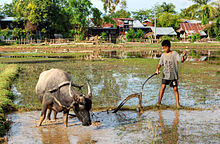
To grow crops regularly in less fertile areas, the soil must be turned to bring nutrients to the surface. A major advance was the mouldboard plough (American spelling: moldboard plow; or turnplough, frame-plough), which not only cuts furrows with a share (cutting blade) but turns the soil. A coulter (or skeith) could be added to cut vertically into the ground just ahead of the share (in front of the frog), a wedge-shaped cutting edge at the bottom front of the mouldboard with the landside of the frame supporting the undershare (below-ground component). The upper parts of the frame carry (from the front) the coupling for the motive power (horses), the coulter and the landside frame. Depending on the size of the implement, and the number of furrows it is designed to plough at one time, a forecarriage with a wheel or wheels (known as a furrow wheel and support wheel) may be added to support the frame (wheeled plough). In the case of a single-furrow plough there is only one wheel at the front and handles at the rear for the ploughman to steer and manoeuvre it.
When dragged through a field the coulter cuts down into the soil and the share cuts horizontally from the previous furrow to the vertical cut. This releases a rectangular strip of sod that is then lifted by the share and carried by the mouldboard up and over, so that the strip of sod (slice of the topsoil) that is being cut lifts and rolls over as the plough moves forward, dropping back to the ground upside down into the furrow and onto the turned soil from the previous run down the field. Each gap in the ground where the soil has been lifted and moved across (usually to the right) is called a furrow. The sod that has been lifted from it rests at about a 45 degree angle in the next-door furrow and lies up the back of the sod from the previous run.
In this way, a series of ploughing runs down a field leaves a row of sods that lie partly in the furrows and partly on the ground lifted earlier. Visually, across the rows, there is the land (unploughed part) on the left, a furrow (half the width of the removed strip of soil) and the removed strip almost upside-down lying on about half of the previous strip of inverted soil, and so on across the field. Each layer of soil and the gutter it came from forms the classic furrow.
The mouldboard plough greatly reduced the amount of time needed to prepare a field, and as a consequence, allowed a farmer to work a larger area of land. In addition, the resulting pattern of low (under the mouldboard) and high (beside it) ridges in the soil forms water channels, allowing the soil to drain. In areas where snow buildup is an issue, this allows the soil to be planted earlier as the snow runoff is drained away more quickly.
There are five major parts of a mouldboard plough:
- Mouldboard
- Share
- Landside
- Frog
- Tailpiece
A runner extending from behind the share to the rear of the plough controls the direction of the plough, because it is held against the bottom land-side corner of the new furrow being formed. The holding force is the weight of the sod, as it is raised and rotated, on the curved surface of the mouldboard. Because of this runner, the mouldboard plough is harder to turn around than the scratch plough, and its introduction brought about a change in the shape of fields – from mostly square fields into longer rectangular "strips" (hence the introduction of the furlong).
An advance on the basic design was the iron ploughshare, a replaceable horizontal cutting surface mounted on the tip of the share. The earliest ploughs with a detachable and replaceable share date from around 1000 BC in the Ancient Near East, and the earliest iron ploughshares from ca. 500 BC in China. Early mouldboards were basically wedges that sat inside the cut formed by the coulter, turning over the soil to the side. The ploughshare spread the cut horizontally below the surface, so when the mouldboard lifted it, a wider area of soil was turned over. Mouldboards are known in Britain from the late 6th century on.
Loy ploughing
Loy ploughing was a form of manual ploughing which took place in Ireland on very small farms or on very hilly ground, where horses could not work or where farmers could not afford them. It was used up until the 1960s in poorer land. This suited the moist climate of Ireland as the trenches formed by turning in the sods providing drainage. It also allowed the growing of potatoes in bogs as well as on mountain slopes where no other cultivation could take place.
Heavy ploughs
In the basic mouldboard plough the depth of the cut is adjusted by lifting against the runner in the furrow, which limited the weight of the plough to what the ploughman could easily lift. This limited the construction to a small amount of wood (although metal edges were possible). These ploughs were fairly fragile, and were not suitable for breaking up the heavier soils of northern Europe. The introduction of wheels to replace the runner allowed the weight of the plough to increase, and in turn allowed the use of a much larger mouldboard faced in metal. These heavy ploughs led to greater food production and eventually a significant population increase around 600 AD.
Before the Han Dynasty (202 BC–220 AD), Chinese ploughs were made almost entirely of wood, except the iron blade of the ploughshare. By the Han period, the entire ploughshare was made of cast iron; these are the first known heavy mouldboard iron ploughs.
The Romans achieved the heavy wheeled mouldboard plough in the late 3rd and 4th century AD, when archaeological evidence appears, inter alia, in Roman Britain. The first indisputable appearance after the Roman period is from 643, in a northern Italian document. Old words connected with the heavy plough and its use appear in Slavic, suggesting possible early use in this region. The general adoption of the mouldboard plough in Europe appears to have accompanied the adoption of the three-field system in the later eighth and early ninth centuries, leading to an improvement of the agricultural productivity per unit of land in northern Europe.
Research by the French historian Marc Bloch in medieval French agricultural history showed the existence of names for two different ploughs, "the ard (araire) was wheeless and had to be dragged across the fields, while the turnplough (charrue) was mounted on wheels".
Improved designs
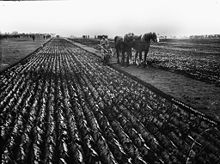
The basic plough with coulter, ploughshare and mouldboard remained in use for a millennium. Major changes in design did not become common until the Age of Enlightenment, when there was rapid progress in design. Joseph Foljambe in Rotherham, England, in 1730 used new shapes as the basis for the Rotherham plough, which also covered the mouldboard with iron. Unlike the heavy plough, the Rotherham (or Rotherham swing) plough consisted entirely of the coulter, mouldboard and handles. It was much lighter than conventional designs and became very popular in England. It may have been the first plough to be widely built in factories.
James Small further improved the design. Using mathematical methods he experimented with various designs until he arrived at a shape cast from a single piece of iron, the Scots plough. A single-piece cast iron plough was also developed and patented by Charles Newbold in the United States. This was again improved on by Jethro Wood, a blacksmith of Scipio, New York, who made a three-part Scots Plough that allowed a broken piece to be replaced. In 1837 John Deere introduced the first steel plough; it was so much stronger than iron designs that it was able to work the soil in areas of the US that had previously been considered unsuitable for farming. Improvements on this followed developments in metallurgy; steel coulters and shares with softer iron mouldboards to prevent breakage, the chilled plough which is an early example of surface-hardened steel, and eventually the face of the mouldboard grew strong enough to dispense with the coulter.
Single-sided ploughing
The first mouldboard ploughs could only turn the soil over in one direction ( conventionally always to the right), as dictated by the shape of the mouldboard, and so the field had to be ploughed in long strips, or lands. The plough was usually worked clockwise around each land, ploughing the long sides and being dragged across the short sides without ploughing. The length of the strip was limited by the distance oxen (or later horses) could comfortably work without a rest, and their width by the distance the plough could conveniently be dragged. These distances determined the traditional size of the strips: a furlong, (or "furrow's length", 220 yards (200 m)) by a chain (22 yards (20 m)) – an area of one acre (about 0.4 hectares); this is the origin of the acre. The one-sided action gradually moved soil from the sides to the centre line of the strip. If the strip was in the same place each year, the soil built up into a ridge, creating the ridge and furrow topography still seen in some ancient fields.
Turnwrest plough
The turnwrest plough allows ploughing to be done to either side. The mouldboard is removable, turning to the right for one furrow, then being moved to the other side of the plough to turn to the left (the coulter and ploughshare are fixed). In this way adjacent furrows can be ploughed in opposite directions, allowing ploughing to proceed continuously along the field and thus avoiding the ridge and furrow topography.
Reversible plough
The reversible plough has two mouldboard ploughs mounted back-to-back, one turning to the right, the other to the left. While one is working the land, the other is carried upside-down in the air. At the end of each row, the paired ploughs are turned over, so the other can be used. This returns along the next furrow, again working the field in a consistent direction.
Riding and multiple-furrow ploughs

Early steel ploughs, like those for thousands of years prior, were walking ploughs, directed by the ploughman holding onto handles on either side of the plough. The steel ploughs were so much easier to draw through the soil that the constant adjustments of the blade to react to roots or clods was no longer necessary, as the plough could easily cut through them. Consequently it was not long after that the first riding ploughs appeared. On these, wheels kept the plough at an adjustable level above the ground, while the ploughman sat on a seat where he would have earlier walked. Direction was now controlled mostly through the draught team, with levers allowing fine adjustments. This led very quickly to riding ploughs with multiple mouldboards, dramatically increasing ploughing performance.
A single draught horse can normally pull a single-furrow plough in clean light soil, but in heavier soils two horses are needed, one walking on the land and one in the furrow. For ploughs with two or more furrows more than two horses are needed and, usually, one or more horses have to walk on the loose ploughed sod—and that makes hard going for them, and the horse treads the newly ploughed land down. It is usual to rest such horses every half hour for about ten minutes.
Heavy volcanic loam soils, such as are found in New Zealand, require the use of four heavy draught horses to pull a double-furrow plough. Where paddocks are more square than long-rectangular it is more economical to have horses four wide in harness than two-by-two ahead, thus one horse is always on the ploughed land (the sod). The limits of strength and endurance of horses made greater than two-furrow ploughs uneconomic to use on one farm.
Amish farmers tend to use a team of about seven horses or mules when spring ploughing and as Amish farmers often help each other plough, teams are sometimes changed at noon. Using this method about 10 acres (40,000 m2) can be ploughed per day in light soils and about 2 acres (8,100 m2) in heavy soils.
Steam ploughing

The advent of the mobile steam engine allowed steam power to be applied to ploughing from about 1850. In Europe, soil conditions were often too soft to support the weight of heavy traction engines. Instead, counterbalanced, wheeled ploughs, known as balance ploughs, were drawn by cables across the fields by pairs of ploughing engines which worked along opposite field edges. The balance plough had two sets of ploughs facing each other, arranged so when one was in the ground, the other set was lifted into the air. When pulled in one direction the trailing ploughs were lowered onto the ground by the tension on the cable. When the plough reached the edge of the field, the opposite cable was pulled by the other engine, and the plough tilted (balanced), putting the other set of shares into the ground, and the plough worked back across the field.
One set of ploughs was right-handed, and the other left-handed, allowing continuous ploughing along the field, as with the turnwrest and reversible ploughs. The man credited with the invention of the ploughing engine and the associated balance plough, in the mid nineteenth century, was John Fowler, an English agricultural engineer and inventor.
In America the firm soil of the Plains allowed direct pulling with steam tractors, such as the big Case, Reeves or Sawyer-Massey breaking engines. Gang ploughs of up to fourteen bottoms were used. Often these big ploughs were used in regiments of engines, so that in a single field there might be ten steam tractors each drawing a plough. In this way hundreds of acres could be turned over in a day. Only steam engines had the power to draw the big units. When internal combustion engines appeared, they had neither the strength nor the ruggedness compared to the big steam tractors. Only by reducing the number of shares could the work be completed.
Stump-jump plough
The Stump-jump plough was an Australian invention of the 1870s, designed to cope with the breaking up of new farming land, that contains many tree stumps and rocks that would be very expensive to remove. The plough uses a moveable weight to hold the ploughshare in position. When a tree stump or other obstruction such as a rock is encountered, the ploughshare is thrown upwards, clear of the obstacle, to avoid breaking the plough's harness or linkage; ploughing can be continued when the weight is returned to the earth after the obstacle is passed.
A simpler system, developed later, uses a concave disc (or a pair of them) set at a large angle to the direction of progress, that uses the concave shape to hold the disc into the soil – unless something hard strikes the circumference of the disk, causing it to roll up and over the obstruction. As the arrangement is dragged forward, the sharp edge of the disc cuts the soil, and the concave surface of the rotating disc lifts and throws the soil to the side. It doesn't make as good a job as the mouldboard plough (but this is not considered a disadvantage, because it helps fight the wind erosion), but it does lift and break up the soil (see disc harrow).
Modern ploughs
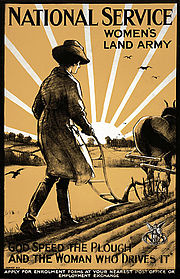
Modern ploughs are usually multiple reversible ploughs, mounted on a tractor via a three-point linkage. These commonly have between two and as many as seven mouldboards – and semi-mounted ploughs (the lifting of which is supplemented by a wheel about halfway along their length) can have as many as eighteen mouldboards. The hydraulic system of the tractor is used to lift and reverse the implement, as well as to adjust furrow width and depth. The ploughman still has to set the draughting linkage from the tractor so that the plough is carried at the proper angle in the soil. This angle and depth can be controlled automatically by modern tractors. As a complement to the rear plough a two or three mouldboards-plough can be mounted on the front of the tractor if it is equipped with front three-point linkage.
Specialist ploughs
Chisel plough
The chisel plough is a common tool to get deep tillage (prepared land) with limited soil disruption. The main function of this plough is to loosen and aerate the soils while leaving crop residue at the top of the soil. This plough can be used to reduce the effects of compaction and to help break up ploughpan and hardpan. Unlike many other ploughs the chisel will not invert or turn the soil. This characteristic has made it a useful addition to no-till and low-till farming practices which attempt to maximise the erosion-prevention benefits of keeping organic matter and farming residues present on the soil surface through the year. Because of these attributes, the use of a chisel plough is considered by some to be more sustainable than other types of plough, such as the mouldboard plough.
The chisel plough is typically set to run up to a depth of eight to twelve inches (200 to 300 mm). However some models may run much deeper. Each of the individual ploughs, or shanks, are typically set from nine inches (229 mm) to twelve inches (305 mm) apart. Such a plough can encounter significant soil drag, consequently a tractor of sufficient power and good traction is required. When planning to plough with a chisel plough it is important to bear in mind that 10 to 15 horsepower (7 to 11 kW) per shank will be required.
Cultivators are often similar in form to chisel ploughs, but their goals are different. Cultivator teeth work near the surface, usually for weed control, whereas chisel plough shanks work deep beneath the surface. Consequently, cultivating also takes much less power per shank than does chisel ploughing.
Ridging plough
A ridging plough is used for crops, such as potatoes or scallions, which are grown buried in ridges of soil using a technique called ridging or hilling. A ridging plough has two mouldboards facing away from each other, cutting a deep furrow on each pass, with high ridges either side. The same plough may be used to split the ridges to harvest the crop.
Scottish hand plough
This is a variety of ridge plough notable in that the blade points towards the operator. It is used solely by human effort rather than with animal or machine assistance, and is pulled backwards by the operator, requiring great physical effort. It is particularly used for second breaking of ground, and for potato planting. It is found in Shetland, some western crofts and more rarely Central Scotland. The tool is typically found on small holdings too small or poor to merit use of animals.
Mole plough
The mole plough or subsoiler allows underdrainage to be installed without trenches, or it breaks up deep impermeable soil layers which impede drainage. It is a very deep plough, with a torpedo-shaped or wedge-shaped tip, and a narrow blade connecting this to the body. When dragged through the ground, it leaves a channel deep under the ground, and this acts as a drain. Modern mole ploughs may also bury a flexible perforated plastic drain pipe as they go, making a more permanent drain – or they may be used to lay pipes for water supply or other purposes. Similar machines, so called pipe-and-cable-laying ploughs, are even used under the sea, for the laying of cables, as well as preparing the earth for side-scan sonar in a process used in oil exploration.
Paraplough
The paraplough or paraplow is a tool for loosening compacted soil layers 12 to 16 inches deep and still maintain high surface residue levels.
Advantages and disadvantages
Mouldboard ploughing, in cold and temperate climates, no deeper than 20 cm, aerates the soil by loosening it. It incorporates crop residues, solid manures, limestone and commercial fertilizers along with some oxygen. By doing so, it reduces nitrogen losses by volatilization, accelerates mineralization and increases short-term nitrogen availability for transformation of organic matter into humus. It erases wheel tracks and ruts caused by harvesting equipment. It controls many perennial weeds and pushes back the growth of other weeds until the following spring. It accelerates soil warming and water evaporation in spring because of the lesser quantity of residues on the soil surface. It facilitates seeding with a lighter seeder. It controls many enemies of crops ( slugs, crane flies, seedcorn maggots-bean seed flies, borers). It increases the number of "soil-eating" earthworms (endogea) but is detrimental to vertical-dwelling earthworms (anecic).
Ploughing leaves very little crop residue on the surface, which otherwise could reduce both wind and water erosion. Over-ploughing can lead to the formation of hardpan. Typically farmers break up hardpan up with a subsoiler, which acts as a long, sharp knife to slice through the hardened layer of soil deep below the surface. Soil erosion due to improper land and plough utilization is possible. Contour ploughing mitigates soil erosion by ploughing across a slope, along elevation lines. Alternatives to ploughing, such as the no till method, have the potential to actually build soil levels and humus, and may be suitable to smaller, more intensively cultivated plots, and to farming on poor, shallow or degraded soils which will only be further damaged by ploughing.
